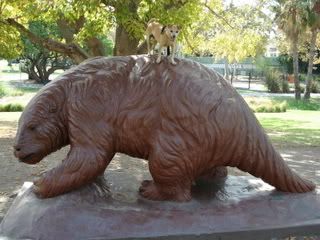
Here, Reggie sits atop a Harlan ground sloth (scientific name: Paramylodon harlani), one of the Pleistocene megafauna found in the park's excavation sites. The Harlan ground sloth was six feet tall when standing.

Here, Reggie sits with a short-faced bear (scientific name: Arctodus simus). Scientists believe that the short-faced bear was the biggest bear that ever lived -- the creature was eleven feet tall on its hind legs.
Scientists have also found sabre-tooth cats, dire wolves, and mammoths at the tar pits, but unfortunately no dinosaurs; they died out 65 million years ago at the end of the Cretaceous period and, at that time, Los Angeles was submerged in the ocean. Ah!
And that's why there's all this "tar" laying around for the animals to fall into. According to the website, the pits are actually deposits of asphalt, the lowest grade of crude oil; oil that was "formed from marine plankton deposited in an ocean basin during the Miocene Epoch (5 - 25 million years ago). Time and pressure converted this material into oil - and for about 40,000 years, this petroleum has been seeping to the surface around Hancock Park."
And that petroleum will suck down anything in its path:
Is entrapment still occurring at Rancho La Brea?
Yes. About 8 -12 gallons (32 - 48 liters) a day ooze and bubble to the surface occasionally trapping invertebrates (insects and worms), reptiles (lizards), birds (mostly pigeons, but also hawks, egrets, ducks, doves, and sparrows), small mammals (rodents and rabbits) and occasionally large mammals (dogs and humans) especially during warm days when the asphalt is softest.
ehhh...

No comments:
Post a Comment